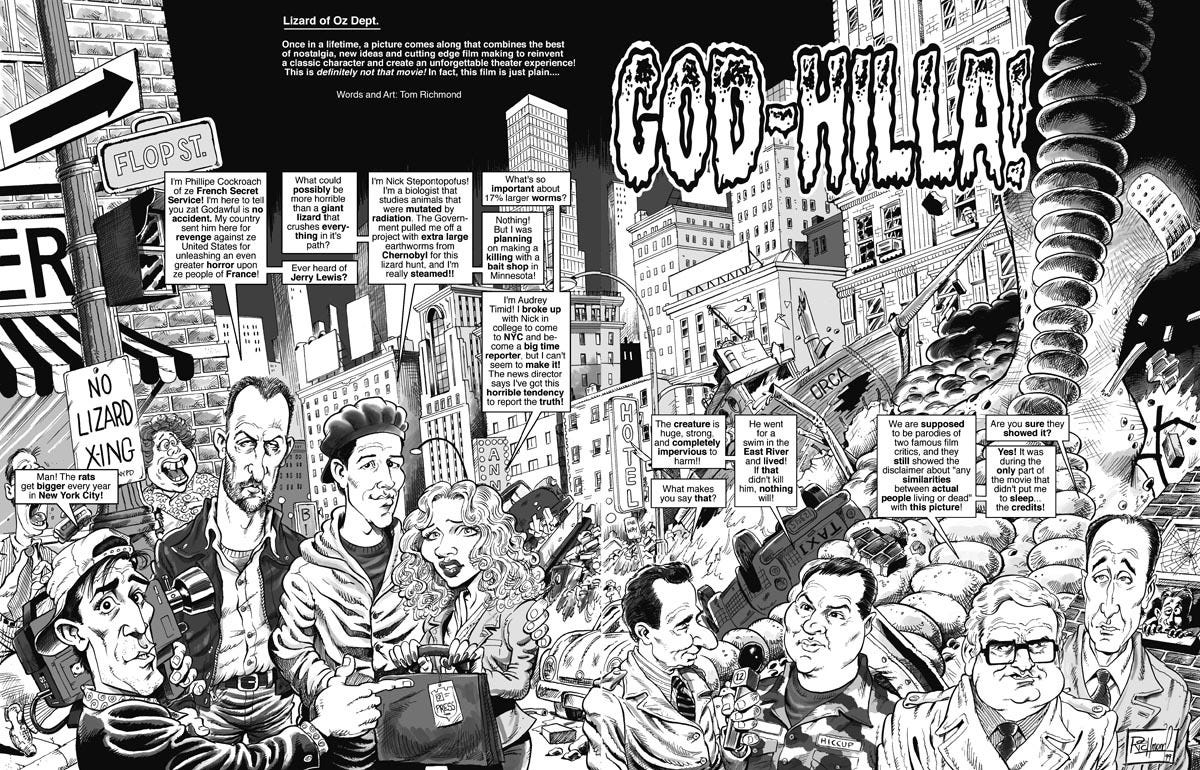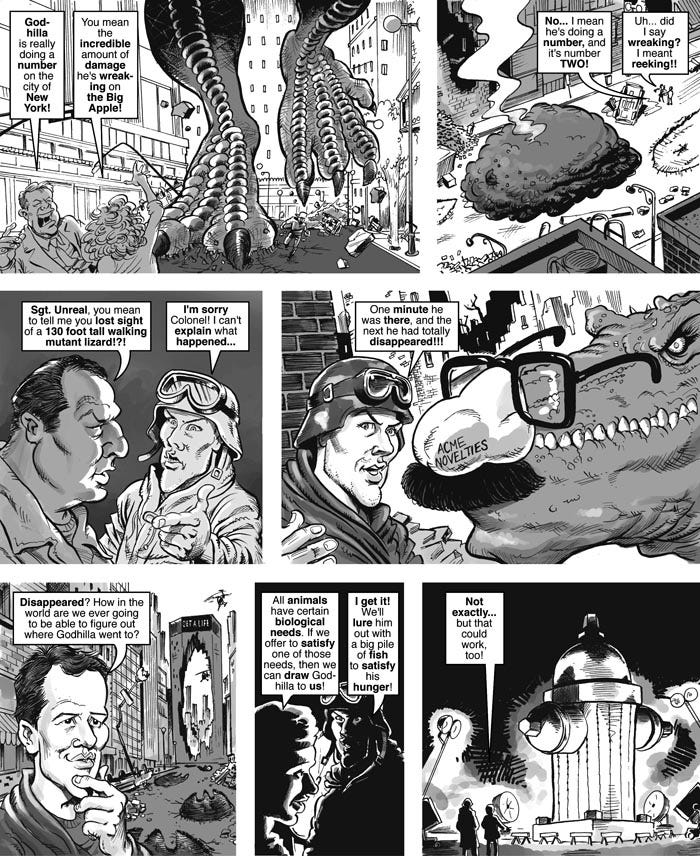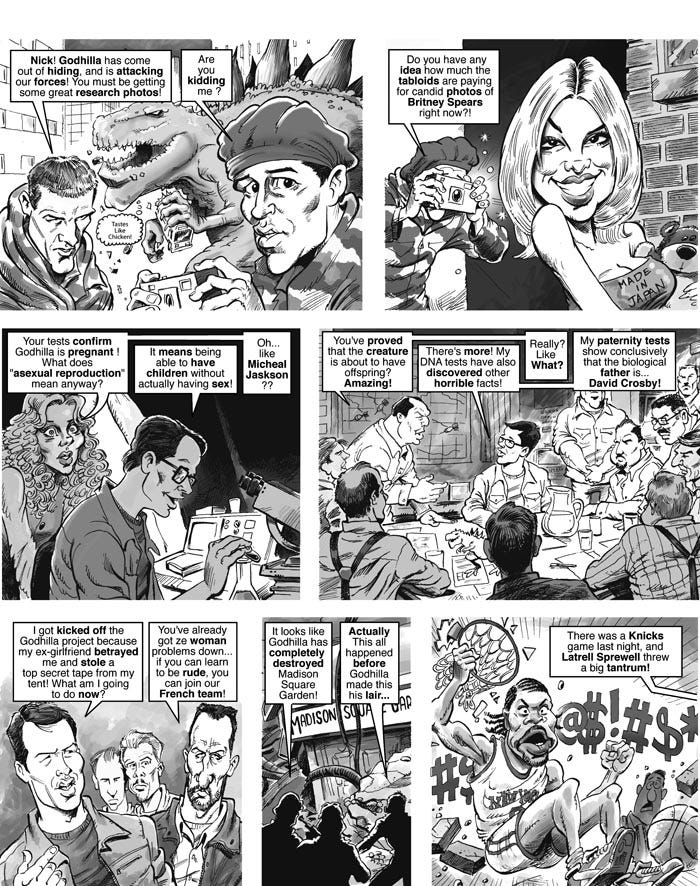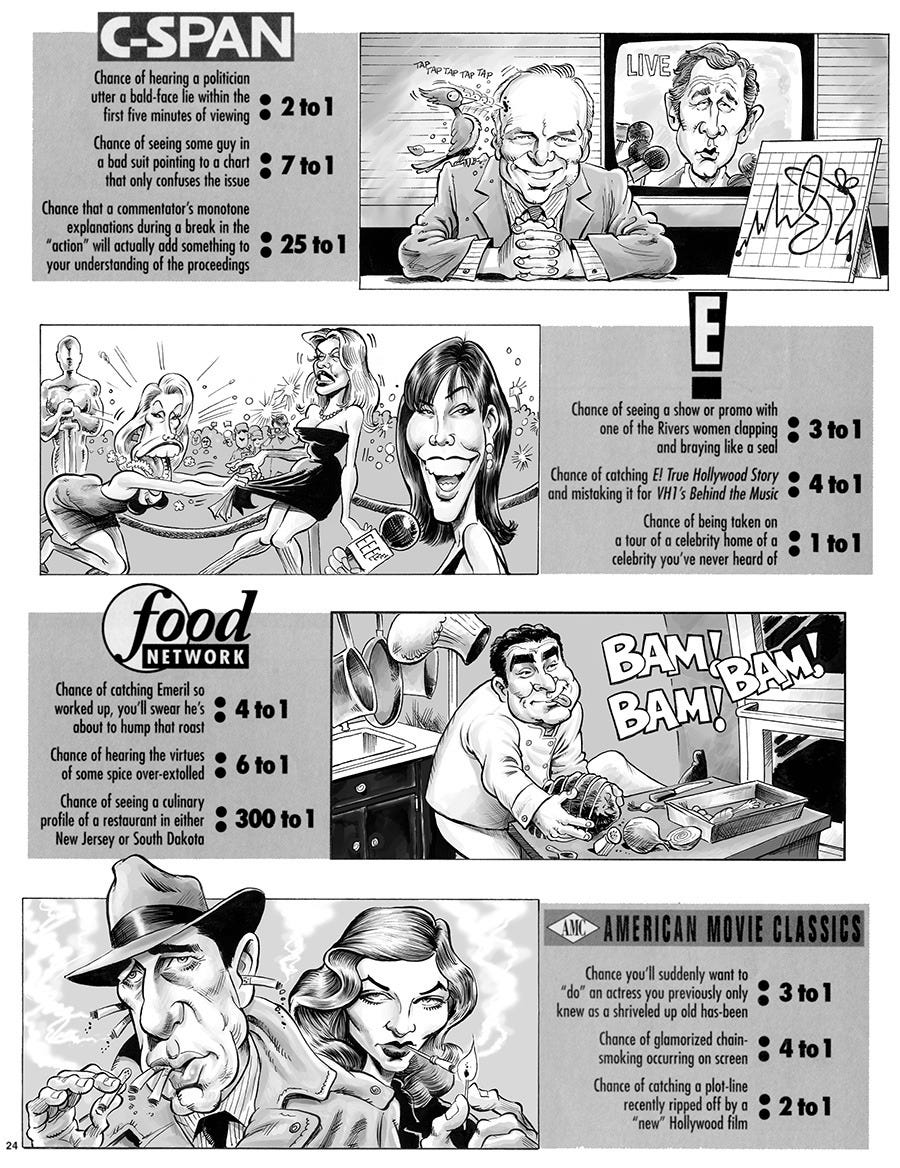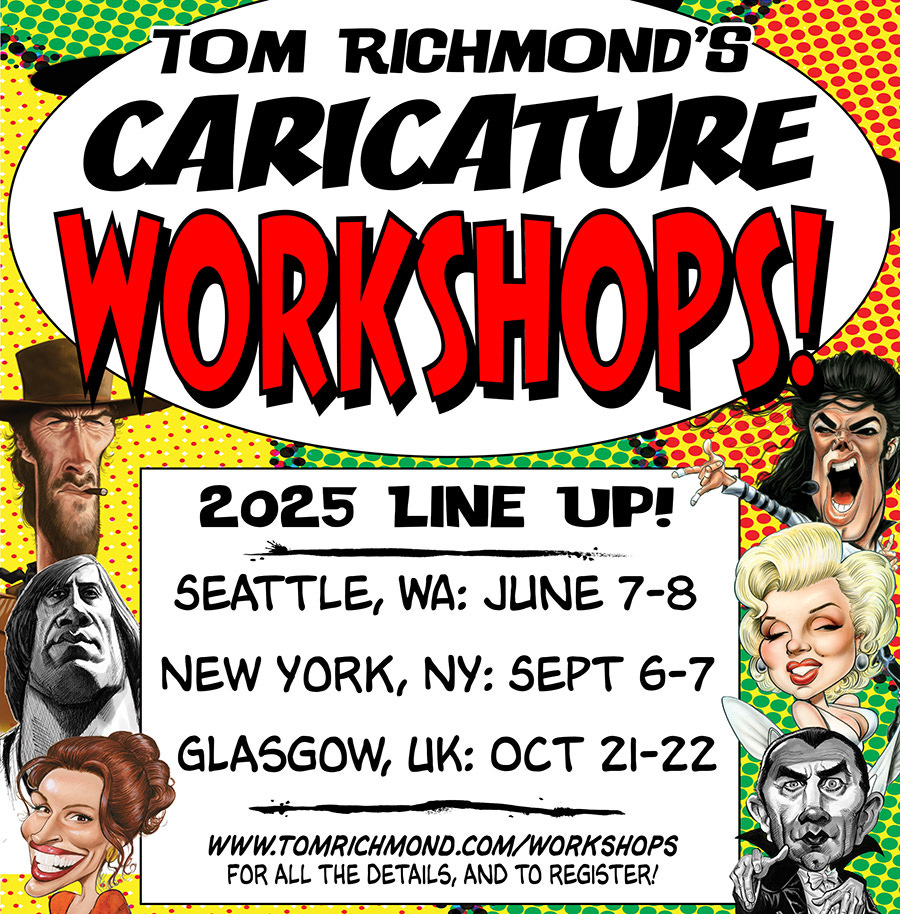The Ink Stained Wretch #186 5/21/25
'Tis But A Sketch, A MAD Break In, Workshop Questions Answered!
Wednesday AGAIN?? Time for another of the pestiferous, putrid, pubescent piles of puffery that are these newsletters! In this episode we carefully consider if our sketch could be carried by an African swallow or a European swallow, we tell the tale of how Tom broke into MAD Magazine, and answer some questions about our caricature workshops...the on with the 'Wretch!
Sketch o'the Week: Graham Chapman!
Click here if you are interested in this original sketch.
We continue with our Monty Python series with the late, great Graham Chapman!
Of all the Pythons, Chapman always seemed to me to be the "quiet one". He always seemed to play the straight man in sketches, and rarely was the one to play the "over the top" crazy characters. The other Pythons often cited Chapman as the best actor of the group, which is probably one reason why he played the lead in both "The Life of Brian" and "Monty Python and the Holy Grail". I'm guessing he was also willing to be the straight man, while the others preferred to do the funnier, goofier roles.
I read that Chapman, who was openly gay, urged the others to avoid jokes with punchlines about stereotypes like race or sexuality. His recurring character "The Colonel", who would often interrupt and end sketches just before the obvious delivery of a very charged and politically incorrect punchline by proclaiming it "too silly", was a way to both include and avoid such jokes.
Chapman died in 1989 at age 48 of tonsil cancer that had spread to his spine. The world got a little less funny that day.
Breaking Into MAD
One question I get often is "How did you break into MAD Magazine?"
I used about 60 feet of rope, a glass cutter, and a crowbar.
Just kidding, of course. But MAD was long considered a "closed shop", and becoming one of the "Usual Gang of Idiots" was considered almost impossible at one time. My road getting into MAD was both a long and a short one. It was long when you consider the time between my first showing my work to a MAD editor and when I got my first assignment (about 10 years), and short if you consider how quickly I ended up with that first assignment after really getting serious about pursuing work with the magazine. That last part was really all about lucky timing.
Like many American boys I had a time when I was really into MAD Magazine. This was between 5th and 7th grades, so I would have been 10-12 years old. My friend had a subscription, so when his copy arrived I would bike over to his place and we’d pour over the new issue, look back at old issues, and then draw cartoons and our own stories in the MAD vein. We also really loved the MAD-like “Wacky Packages”, and we’d do our own parodies of products and stuff we saw in our parent’s cabinets and about the house. Fun stuff, but then I moved away with my family and didn’t see another copy of MAD for about 6 years. If you’d asked me at that time if I wanted to draw for MAD, I would have enthusiastically said “YES!”, but what did I know? I was just a kid.
When I was eighteen I got a job doing caricatures at a theme park near Chicago called Six Flags Great America. I moved down there and lived in a town home with five other artists and near another townhome with four more of the crew. Many of these guys had brought copies of MAD and they were laying around the place, so I got another look at the magazine I had loved as a kid. Having now had a year of art school under my belt, some actual experience in doing caricature, and having decided humorous illustration was something I wanted to pursue, I was stunned at the brilliance of the artwork in the magazine. I did not remember the art being so incredible… as a kid I just thought it was really funny. As an adult, I realized now how amazing it was. That’s about the time I thought working for MAD would be pretty cool. I had no illusions about doing it anytime soon, as I knew my work as a LOOOOOONG way from being good enough to be in the magazine. Maybe someday. This was 1985.
Years later I started doing comic book work for “NOW Comics” out of Chicago, and attended my first San Diego Comic-Con as a professional in 1992. MAD editor Nick Meglin happened to be there, looking at portfolios for DC Comics. In those days, SDCC was small enough that you could just stand in line to get your portfolio looked at by the bigger companies. I showed Nick my "Married...with Children" work and he basically dismissed it without any encouragement. I didn’t really think I had a chance at that time anyway, but that was sort of discouraging so I didn’t bother to send any work to MAD as a follow up. In the meantime I moved on from comics to start doing magazine illustration, advertising and the like. After that I mostly forgot about MAD, and didn’t pick up a copy of the magazine again for years. Like I said MAD was still very much a “closed shop” at that time anyway… new freelancers rarely showed up in its pages.
Sometime in the late 90’s, after years of hearing people tell me “you should work for MAD Magazine”, I started thinking about giving it a try again and began to pick up recent issues. This time I noticed something different…a few new names were appearing under artist credits in the magazine along side the usual suspects. That got me thinking that maybe there were some doors that might be peeking open at MAD that had previously been locked tight.
By this time I was keeping steady with decent paying, if not nationally distributed, freelance work, and the quality of my work had progressed. I thought it might be time to send some work into MAD, although I was still not convinced I had the chops for it quite yet. In 1998, I had the opportunity to correspond with the great Mort Drucker thanks to the efforts of my wife, The Lovely Anna. After showing him my work, Mort encouraged me to give it another try with MAD.
In 1999 I attended my first National Cartoonists Society Reuben Weekend, and got the opportunity to show my work to Nick Meglin again, this time with the help of DC/MAD book editor Charlie Kochman. Nick of course didn’t remember me from seven years earlier at Comic-Con, and while he wasn’t overly impressed with my stuff he had a lot more encouraging words for me. Charlie was also very supportive. He pointed to specific pieces of mine that he said were very close to the kind of work MAD responded to, and strongly encouraged me to keep sending in new pieces for review. It was about that time when I began to think I could really make this happen.
That same year I became president of the National Caricaturist Network (now the International Society of Caricature Artists), and I planned a mini-con for the organization around the opening of an exhibition of the work of Al Hirschfeld in New Britain, CT. I invited long time MAD artist (and newly instated art director) Sam Viviano to be our guest speaker. Of course I had an ulterior motive…I was going to have Sam’s one-on-one attention all weekend. In anticipation of this, I wrote and drew an entire movie parody (“Godzilla”, the 1996 Matthew Broderick version). Here is that entire six page spoof as it eventually appeared in Cracked:
Once again I was told my work was not quite good enough for the magazine, but Sam was very encouraging and wanted me to continue to send him work. By this time I really did have my sights set on breaking into MAD. I believed if I worked hard enough at improving my skills, I could do it.
Around that time the longtime MAD copycat publication Cracked was bought out (as part of a deal for the entire publishing line of parent company Globe Communications) by American Media Inc, which published the tabloid Weekly World News. AMI took one look at the sales of Cracked and wanted to kill the magazine, but one of the Weekly World News‘ art directors was a cartoonist named Dick Kulpa, who convinced AMI to let him take over Cracked. I showed my “Godzilla” parody to him, and he immediately bought and published it. I went on to do three more parodies for Cracked. Each time I completed one, I sent it to Sam at MAD, who got back to me with feedback and increasing encouragement.
Sometime during my time with Cracked but before MAD I took a trip to NYC and met up with Sam and the MAD offices. Much to my surprise, he and Nick Meglin took me to lunch at the Society of Illustrators. Nick gave me some advice as to what I needed to do to get my work to a place where MAD would be interested in using it. Basically, we said that while my style was not what he would consider a “copycat” of Mort Drucker’s style, they felt my work was too heavily influenced by Mort’s stuff. MAD famously refused to use work by artists who aped the styles of their well-known contributors. I needed to move farther away from Mort’s style and let my own voice grow. To paraphrase, he said “We don’t need another Mort Drucker, we already have him. We want a Tom Richmond.”
This opened my eyes to the fact that, while trying so hard to unlock the nuts and bolts of the movie/TV parody genre, I was continually poring over Mort’s classic parodies. While I never consciously copied any elements of Mort’s drawing, looking at it all the time inevitably caused his style to creep more into my work. So, I put away all my MAD magazines and did my last few Cracked parodies without looking at any other spoofs for inspiration.
In May of 2000 I attended another NCS Reuben Weekend, this one in New York City. I showed Sam my latest work, including a parody of the movie “Gladiator” I’d just finished for Cracked. Here's the splash page for that parody:
This time he saw something he liked and said he thought they would like to give me some work, but he could not promise when that would happen. He also said there was a problem in that no artist working for MAD could have a by-line in a current issue of Cracked.
“That’s no problem” I said, “I don’t draw for Cracked anymore.”
“”Really?” he responded, “When did that happen?”
“Three seconds ago,” I replied.
In reality I had already decided I was never going to do another job for Cracked again for a number of reasons. Sam wanted to impress upon me that he had no idea when they might find an assignment that would work for me that none of their regulars was available for. I told him I would patiently wait for that call.
I got it about a month later, and did a three page piece for them entitled “MAD‘s Cable TV Viewing Odds”. Here's that piece as it eventually appeared in MAD:
This was an “evergreen” piece, which is something they often give to new contributors as a kind of try out job. “Evergreen” means the subject matter is not timely, so they can be run anytime, or not at all if they don’t turn out. These are often assigned to new people and then go into the “evergreen drawer” where they can be pulled out and used to fill in if another piece was delayed or they decided not to run something for whatever reason. That’s actually what happened with this piece. It was bumped and did not run until issue #406, June 2001. By then I had been in five issues and done both a movie and TV parody.
Sam denies this, but I still think that part of the reason I got my shot in MAD was because they were about to switch to a color format and I was able to color my own work and deliver it digitally. They needed someone to do movie and TV parodies that could do that.
So, that’s how I got into MAD. It was a combination of perseverance, a willingness to look at my own work with an impartial eye, take constructive criticism to heart, dumbass luck, and timing.
Caricature Workshop Most FAQ
I get a lot of questions about my workshops... like "is coffee included?" and "when is lunch?". But the number one question I get is:
"Do I have to be a professional level artist to take the workshop?"
The answer to that one is definitely not.
When I started doing these workshops, I wanted to format them so what I taught could be applied to artists that worked in any style and of (almost) any skill level.
The style part just means what I teach works no matter what style of work an artist does. Whether you are a cartoonist, comic book artist, sculptor, realistic painter... whatever... the underlying principles of creating a caricature are the same. We all create art a little differently, but good caricature is universal across all styles and techniques.
As far as skill level goes, you should have basic drawing skills. Every workshop I do has at least one total beginner and one seasoned pro, and all skill levels in between. I've been told that artists who do work completely outside the world of caricature really liked taking the class. I've had wildlife painters, woodcarvers, portraitists, comic book artists, comic strip cartoonists, sculptors, animators... you name it... do the workshop and enjoy it.
I also have hobby artists, people who just love to draw, retirees looking for a unique art experience, sometime even just longtime fans of MAD who want to peek behind the curtain, be part of the workshop. All are made to feel welcome and encouraged no matter their level of ability. I would say you should be capable of more than just stick figures, but even very amateur artists will learn a lot at one of the workshops.
There are very few in person caricature classes out there, so it's a unique opportunity.
And yes, there's coffee.
Regular Subscriber? That's it for another lame issue of the 'Wretch! Thank you for subscribing! As always, if you liked what you saw please share it with others. Remember I'm always looking for feedback, questions for the mailbag, and suggestions for future Sketch o'the Week subjects. Just reply to this email with any of the above, or leave a comment on Substack! And always remember... it's crackers to slip a rozzer the dropsy in snide!
You can watch me draw this Graham Chapman sketch, get a 20% Studio Store discount, access the entire ISW archive, and help support this newsletter by becoming a Premium Subscriber:
Keep reading with a 7-day free trial
Subscribe to The Ink Stained Wretch to keep reading this post and get 7 days of free access to the full post archives.









